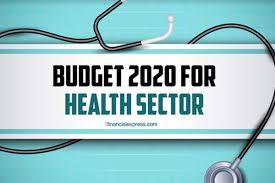Budget 2020-2021: healthcare sector gets big boost with Rs 69000 crores. Analysis of healthcare in the Union Budget 2020-2021. Overall the union budget has focussed on the holistic health approach. The healthcare sector will get an allocation of Rs 69000 crores in the budget.


Overall the Union Budget 2020-2021 has focussed on the Holistic Health Approach. All aspects of health, that is, preventive health, promotive health and curative health, have been addressed. This budget and the finance Minister have taken historic baby steps towards increasing the GDP spend on Healthcare by the Government from the meagre 1.2 % towards the goal of 3-4 % of GDP by 2024.The healthcare sector will get an allocation of Rs 69000 crores in the budget.
- First let me put some facts on the table : The contribution of chronic respiratory diseases to the total DALYs in India increased from 4·5% (95% UI 4·0–4·9) in 1990 to 6·4% (5·8–7·0) in 2016. Of the total global DALYs due to chronic respiratory diseases in 2016, 32·0% occurred in India. COPD and asthma were responsible for 75·6% and 20·0% of the chronic respiratory disease DALYs, respectively, in India in 2016. The number of cases of COPD in India increased from 28·1 million (27·0–29·2) in 1990 to 55·3 million (53·1–57·6) in 2016, an increase in prevalence from 3·3% (3·1–3·4) to 4·2% (4·0–4·4). Of the DALYs due to COPD in India in 2016, 53·7% (43·1–65·0) were attributable to air pollution, (Reference: The Lancet, Global Health- Article-VOLUME 6, ISSUE 12, PE1363-E1374, DECEMBER 01, 2018).
The most important steps taken by the finance minister to put a cap on the burden of respiratory diseases (7% deaths in India due to respiratory diseases) to enhance clean air environment.
- the proposal to incentivize farmers to put up stand-alone solar plants on barren lands for producing electricity
- putting large solar capacity plants on railway land alongside tracks for electrification of 11,000kms of track electrification
- warning to old thermal plants to switch to cleaner renewal alternatives in cities of more than 1 million population for which allotment of Rs 4400 crores has been made
- Allotment of Rs 22000 crores for renewable energy sector
- The Finance minister for the first time in a budget speech stressed the importance of the three diseases of bovine – human transmission – Foot & Mouth disease, PPR and Brucellosis. She has envisaged steps to eliminate these by 2025. Hand, foot and mouth disease usually affect infants and children. The Estimated annual loss due to livestock diseases in India: Annual loss (Rs in crores.) FMD Rs 14000 15000; PPR Rs 1690-1800. Enhanced spread of brucellosis through increased distribution of potentially infected animal products poses significant social, economic, and public health threats. Brucellosis is an important re-emerging infectious disease worldwide with India being no different. In India, about 80% of people live within close contact to domestic livestock animals or wildlife, a critical risk factor for zoonotic disease transmission such as brucellosis; Seroprevalence studies suggest infection may range between 0.9% – 18.1%,
- The addition of 5 more vaccines to the “Mitra Indradhanush” vaccination program is one of the highlights.
- Health of India cannot be sustained if the basic focus is not on prevention. Hence, the focussed “Jal Jeevan Mission” for supply of safe potable drinking water to all villages is a very welcome initiative where Rs 11500 crores has been allocated. Similarly, Rs 11300 crores has been allocated to “Swatch Bharat Mission “for sanitation to make India open defecation free (ODF). Together, these will control morbidity and mortality especially in infants in the rural areas due to water borne diseases and control of anaemia in women due to hookworm infestation. Annually about 37.7 million Indians are affected by waterborne diseases, 1.5 million children die of diarrhoea and 73 million working days are lost leading to an economic burden of $600 million a year.(published Jan 9, 2019 )
- Forensic Medicine, a subject given no importance till now, will get a big boost, due to the proposal of establishment of a National Forensic University. This will help produce more experts in Forensic medicine who in turn can help track crimes like sexual assaults of women and children which are on the rise in India. “Clinical forensic medicine includes all medical (healthcare) fields which may relate to legal, judicial, and police systems” (Ref:Payne-James, 1994). In part this increased relevance relates to much wider awareness of human rights abuses and civil liberties which in turn have directed much attention to the conditions of detention of prisoners, and to the application of justice to both victim and suspect. The differing and potentially conflicting roles that a forensic physician may have when attending a prisoner or other person detained by the state or other body have been recognized by identifying three possible facets of medical care: (1) the role of medico legal expert for a law enforcement agency, (2) the role of a treating doctor, and (3) the examination and treatment of detainees who allege that they have been mistreated by the police during their arrest, during interrogation, or during the various stages of police custody. This conflict is well recognized by forensic physicians (Lancet, 1993).
- Under the Ayushman Bharat Health scheme of the Prime Minister, it has been proposed to cover all 112 aspirational districts by empanelling hospitals on priority basis. The financial viability of such hospitals will be sustained through PPP basis. This will cover a wider population of the tier II and tier III cities and rural population for the benefits of treatments under this scheme.
- It has been proposed to cover all Districts in the country by the “Jan Aushadi Kendras” by 2024 so that medicines will be available at cheap rates to the entire population covered. This will bring down out of pocket (OOP) expenses on healthcare of a large section of our population. Presently, almost 78% of the population spends OOP on healthcare.
- The Ayushman Bharat mission will be benefitted by the proposed use of Artificial Intelligence. This will help plug the gaps in record keeping, quicker detection of frauds, better diagnosis and also follow ups, etc
- To address the issue of shortage of doctors in the country, every district hospital will be allowed to be attached to one medical college under the PPP scheme. This will address viability gap funding. More private sector players will therefore, enter the medical education sector. Moreover, large private hospitals will be allowed to start DNB and Fellowship PG programs, by easing the present norms. This will increase the pool of specialists and super specialist doctors in our country. Also, the finance minister has allocated Rs 3000 crores for special bridge courses in skill development for training paramedics, technicians and nurses which too are in short supply in our country.
- The new scheme announced by the finance minister for the manufacture of electronic goods include bio-medical and medical devices will be of great significance to the healthcare sector. This will bring down the cost of medical devices and can help bring down cost of capital investment of new hospitals for private players.
- The medical textiles industry is a huge ancillary industry for the healthcare sector especially hospitals. This sub-sector of the healthcare will get a boost as the finance minister has allocated Rs 1480 crores for the textile sector.
- New investments in healthcare will be a welcome step for our country. The new Investment clearance cell to be set up at the centre and the state levels can boost growth of new hospitals, pharmaceutical units, medical devices manufacturing units, consumables manufacturing units, etc of the healthcare sector.
- The launch of “National Infrastructure pipeline” which includes healthcare has been allocated Rs 103 lakh crores. This will boost growth of all sub-sectors of healthcare like new hospitals, pharmaceutical units, medical devices manufacturing units, consumables manufacturing units, medical textiles, etc
- The proposed development of 2000 kms of highways will boost the sub-sectors of healthcare namely, establishment of Trauma centres and ambulance manufacturing and services.
- The investment of Rs 6000 crores for the “Bharat Net Program “will bring in digital connectivity to one hundred thousand gram panchayats through optical fibre. This will greatly boost investments in equipment for Tele-medicine and also expand healthcare services through the hub and spoke model of healthcare.
- The allotment of Rs 28600 crores for the Nutritional programs will be a great boost to lower infant and child mortality rates down, lower maternal mortality rates down and anaemia in pregnant women . The major nutritional problems in India are protein energy malnutrition (PEM), vitamin A deficiency (VAD), iron deficiency anemia (IDA) and iodine deficiency disorders (IDD). Malnutrition was the predominant risk factor for death in children younger than five in every state of India in 2017, accounting for 68.2 per cent of the total under-5 deaths, translating into 706,000 deaths (due to malnutrition). Hence the importance of the budget allocation. The allocation of Rs 28600 crores for women specific programs will also address health issues in women and child by indirect means.
- Corporate hospitals will be able to give better services (hopefully) as they will also benefit through the abolition of dividend distribution tax.
- The investments in start-ups in healthcare have been a bit slow. Healthcare start ups especially those in AI, bio-informatics, genetics, etc will be greatly benefitted as the turn over limit has been increased to Rs 100 crores and exemption in tax has been extended to 10 years. Similarly, healthcare start ups will also be benefited as ESOPS tax has been deferred to 5 years.
- It has been proved that control of sexually transmitted diseases; control of abortions, un-wanted pregnancies control and family planning programs are successful when the women in the society are educated. Hence, the “Beti padhao” program will go a long way to improve “social health” in our country. The “Beti Bachao” program will go a long way to increase the sex ration of female to male in our country. The finance minister promised to give a boost to these programs.
- The new “Charitable Hospitals” will greatly benefit from the on-line registration process being extended upto 3 years. This will also end manual processing.
Lastly, there will be a negative impact on the import of medical equipment and make them more costly, as there will be a health Cess on medical devices and equipment. (80% of medical equipment is imported).This will be passed on to the common man by the industry thus defeating the other benefits given to the private healthcare sector.


Dr Rajeev Boudhankar, MD, PhD, MPhil, DHA
Adviser- Hira Mongi Navneet Hospital, Mumbai.











